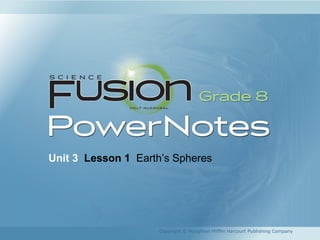Contenu connexe
Similaire à U3L1 - Earth's Spheres (20)
U3L1 - Earth's Spheres
- 1. Unit 3 Lesson 1 Earth’s Spheres
Copyright © Houghton Mifflin Harcourt Publishing Company
- 2. Unit 3 Lesson 1 Earth’s Spheres
Indiana Standards
Copyright © Houghton Mifflin Harcourt Publishing Company
• 8.2.1 Recognize and demonstrate how the sun’s
energy drives convection in the atmosphere and in
bodies of water, which results in ocean currents
and weather patterns.
• 8.2.2 Describe and model how water moves
through the earth’s crust, atmosphere, and oceans
in a cyclic way, as liquid, vapor, and solid.
- 3. Unit 3 Lesson 1 Earth’s Spheres
Indiana Standards
Copyright © Houghton Mifflin Harcourt Publishing Company
• 8.2.3 Describe the characteristics of ocean
currents and identify their effects on weather
patterns.
• 8.2.4 Describe the physical and chemical
composition of the atmosphere at different
elevations.
- 4. What on Earth?
Copyright © Houghton Mifflin Harcourt Publishing Company
What is the Earth system?
• A system is a group of related objects or parts
that work together to form a whole.
• The Earth system is all of the matter, energy,
and processes within Earth’s boundary.
• Earth is a complex system full of living and
nonliving things and the matter and energy that
continuously cycle through the smaller systems.
Unit 3 Lesson 1 Earth’s Spheres
- 5. What is the Earth system?
• The geosphere is the mostly solid, rocky part of
Earth. It extends from the center of Earth to the
surface of Earth.
• The crust is the thin, outermost layer of the
geosphere.
• Oceanic crust is 5 to 10 km thick.
• Continental crust is 15 to 70 km thick.
Copyright © Houghton Mifflin Harcourt Publishing Company
Unit 3 Lesson 1 Earth’s Spheres
- 6. What is the Earth system?
• The mantle is below the crust. It is about
2,900 km thick.
• A small layer of solid mantle, right below the
crust, flows and causes movement of the plates of
the crust.
• The core of Earth has a radius of about 3,900 km.
It is made of iron and nickel.
Copyright © Houghton Mifflin Harcourt Publishing Company
Unit 3 Lesson 1 Earth’s Spheres
- 7. What is the Earth system?
• Describe the characteristics of the layers of Earth.
Copyright © Houghton Mifflin Harcourt Publishing Company
Unit 3 Lesson 1 Earth’s Spheres
- 8. Got Water?
Copyright © Houghton Mifflin Harcourt Publishing Company
What is the hydrosphere?
• The hydrosphere is the part of Earth that is
liquid water.
• Oceans, lakes, rivers, marshes, and groundwater
are all part of the hydrosphere.
• Water is constantly moving through Earth and
even into and out of living things.
Unit 3 Lesson 1 Earth’s Spheres
- 9. What is the cryosphere?
• The cryosphere is made up of all of the frozen
water on Earth.
• Snow, ice, sea ice, glaciers, ice shelves, icebergs,
and frozen ground are all part of the cryosphere.
• Changes in the cryosphere can play an important
role in Earth’s climate and species’ survival.
Copyright © Houghton Mifflin Harcourt Publishing Company
Unit 3 Lesson 1 Earth’s Spheres
- 10. What a Gas!
Copyright © Houghton Mifflin Harcourt Publishing Company
What is the atmosphere?
• The atmosphere is a mixture of mostly invisible
gases that surrounds Earth.
• About 78 percent of the atmosphere is nitrogen.
Oxygen makes up 21 percent of the atmosphere.
Unit 3 Lesson 1 Earth’s Spheres
- 11. What is the atmosphere?
• Other gases in the atmosphere include argon,
carbon dioxide, and water vapor.
• Some of the energy from the sun is trapped by
Earth’s atmosphere, which helps keep
temperatures high.
Copyright © Houghton Mifflin Harcourt Publishing Company
Unit 3 Lesson 1 Earth’s Spheres
- 12. What is the atmosphere?
• Part of the atmosphere absorbs and reflects
harmful ultraviolet (UV) rays from the sun.
• Other parts of the atmosphere cause space debris
to burn up before reaching Earth’s surface.
Copyright © Houghton Mifflin Harcourt Publishing Company
Unit 3 Lesson 1 Earth’s Spheres
- 13. What is the biosphere?
• The biosphere is made up of living things and the
areas of Earth where they are found.
• Organisms usually need oxygen or carbon dioxide
to carry out life processes.
• Liquid water, moderate temperatures, and a
stable source of energy are also important for
most living things.
Copyright © Houghton Mifflin Harcourt Publishing Company
Unit 3 Lesson 1 Earth’s Spheres
- 14. What’s the Matter?
Copyright © Houghton Mifflin Harcourt Publishing Company
How do Earth’s spheres interact?
• All of the five spheres of Earth interact as matter
and energy change and cycle through the system.
• If matter or energy never changed from one form
to another, life on Earth would not be possible.
Unit 3 Lesson 1 Earth’s Spheres
- 15. How do Earth’s spheres interact?
• Matter moves between Earth’s spheres.
• Sometimes, matter moves through many spheres
before returning to a sphere.
• Energy moves between spheres. Energy also
moves back and forth between spheres.
Copyright © Houghton Mifflin Harcourt Publishing Company
Unit 3 Lesson 1 Earth’s Spheres
- 16. How do Earth’s spheres interact?
• How many of the parts of the Earth system can you identify
in this image? How do they interact?
Copyright © Houghton Mifflin Harcourt Publishing Company
Unit 3 Lesson 1 Earth’s Spheres

